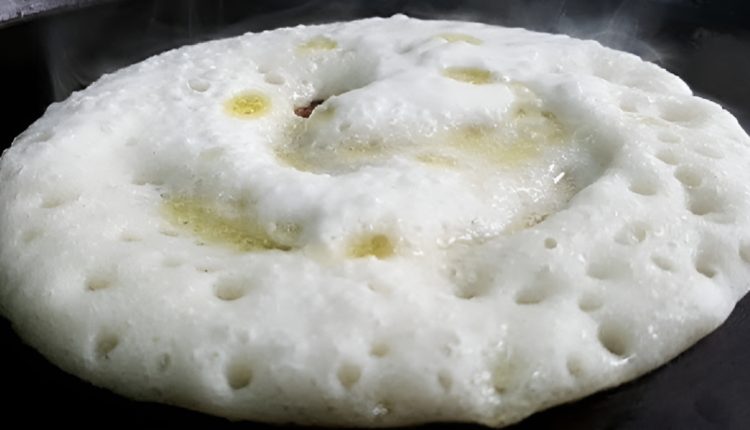ഒരുതവണയെങ്കിലും ഉണ്ടാക്കിനോക്കൂ.. അതിരാവിലെ ഒരു കിടിലൻ തട്ടിൽകുട്ടി ദോശ കഴിക്കാം; ഏറ്റവും എളുപ്പത്തിൽ| Perfect Thattukada Style Dosa Recipe
Perfect Thattukada Style Dosa Recipe: നമ്മൾ ഇന്ന് ഇവിടെ ഉണ്ടാക്കാൻ പോകുന്നത് ഒരു അടിപൊളി ദോശയുടെ റെസിപ്പിയാണ്. ഇത് വെറുമൊരു ദോശയുടെ റെസിപ്പിയല്ല; പഞ്ഞിപോലെ വായിൽ അലിഞ്ഞു പോകുന്ന തട്ടുകടയിലെ തട്ടുദോശയാണിത്. ഇത് നല്ല ചമ്മന്തിയുടെ കൂടെയോ സാമ്പാറിന്റെ കൂടിയോ ഒക്കെ നമുക്ക് കഴിക്കാവുന്നതാണ്.
Ingredients:
- പച്ചരി – 2 കപ്പ്
- വേവിച്ച അരി – 1 കപ്പ്
- ഉഴുന്ന് പരിപ്പ് – ¼ കപ്പ്
- ഉലുവ – 1 ടേബിൾസ്പൂൺ
- ഉപ്പ് – രുചിക്ക്
- നെയ്യ് / നല്ലെണ്ണ – ആവശ്യത്തിന്
Ingredients:
- Green rice – 2 cups
- Cooked rice – 1 cup
- Roasted lentils – ¼ cup
- Fenugreek – 1 tablespoon
- Salt – to taste
- Ghee / Oil – as needed
How to Make Perfect Thattukada Style Dosa Recipe
അപ്പോൾ ഇത് എങ്ങിനെയാണ് തയ്യാറാക്കുന്നത് എന്ന് നോക്കാം. ഇതിനായി ആദ്യം ഒരു ബൗളിലേക്ക് പച്ചരി, പുഴുക്കലരി, ഉലുവ എന്നിവ എടുത്ത് കഴുകി വൃത്തിയാക്കി 6 മണിക്കൂർ വെള്ളത്തിൽ കുതിർക്കാൻ വെക്കുക. അതുപോലെ മറ്റൊരു ബൗളിൽ ഉഴുന്ന് എടുത്ത് നല്ലപോലെ കഴുകി 3 മണിക്കൂർ വെള്ളത്തിൽ കുതിർക്കാൻ വെക്കുക. എന്നിട്ട് ഒരു മിക്സിയുടെ ജാറിലേക്ക്
കുതിർത്ത ഉഴുന്ന്, ചോറ്, വെള്ളം എന്നിവ ചേർത്ത് അരച്ചെടുക്കുക. അതുപോലെ കുതിർത്ത അറിയും ചോറും അരച്ചെടുക്കാം. ഇത് രണ്ടും ഒരു ബൗളിലേക്കാകുക. എന്നിട്ട് അതിലേക്ക് ആവശ്യത്തിന് ഉപ്പ് ചേർത്ത് മിക്സ് ചെയ്യുക. റെസിപ്പിയുടെ ചേരുവകളും പാചക രീതിയും എങ്ങനെയെന്നു വീഡിയോയിൽ വിശദമായി കാണിച്ചു തരുന്നുണ്ട്. Perfect Thattukada Style Dosa Recipe| Video credit: CURRY with AMMA
Here is a recipe for perfect Thattukada-style dosa, which are known for being soft, spongy, and slightly thick, unlike the thin, crispy dosas you might find elsewhere. The key lies in the specific batter ingredients and the fermentation process.
Ingredients for the Batter
The secret to the unique texture of Thattukada dosa lies in the combination of different types of rice and lentils.
- Parboiled Rice / Idli Rice: 2 cups
- Raw Rice: 1 cup
- Urad Dal (Split black gram): 1/2 cup
- Fenugreek Seeds (Methi): 1 teaspoon
- Cooked Rice / Poha (Flattened rice): 1/2 cup (This is a key ingredient for a soft and fluffy texture.)
- Salt: to taste
- Water: as needed for soaking and grinding
Preparation: Soaking & Grinding
- Soaking: Rinse the parboiled rice, raw rice, urad dal, and fenugreek seeds thoroughly until the water runs clear. Soak them together in a large bowl with enough water for 4-6 hours, or overnight. In a separate bowl, soak the cooked rice or poha for about 20-30 minutes before grinding.
- Grinding:
- First, drain the water from the soaked rice and lentil mixture.
- Use a wet grinder or a high-speed blender.
- Add the soaked urad dal, fenugreek seeds, and the soaked cooked rice/poha to the grinder. Add a small amount of cold water and grind to a smooth, fluffy, and frothy paste. It’s important to use cold water or even ice cubes to prevent the batter from heating up while grinding, which can hinder fermentation.
- Transfer the urad dal mixture to a large vessel.
- Next, add the soaked rice to the grinder. Grind the rice to a slightly coarse, rava-like consistency. Do not make it a very fine paste, as the slight coarseness contributes to the dosa’s texture.
- Mix the ground rice batter with the urad dal batter in the large vessel. Mix everything thoroughly with your clean hands. The warmth from your hands can help jump-start the fermentation process.
Fermentation
- Fermentation is crucial: Cover the batter and place it in a warm location to ferment. The time required for fermentation depends on the climate. In a warm, humid climate, it may take 6-8 hours. In colder climates, it could take 12-14 hours or even longer. You can place it in a switched-off oven with the light on to create a warm environment.
- Check for Fermentation: The batter is ready when it has risen in volume, has a pleasant fermented aroma, and you see small air pockets. If you didn’t add salt before, now is the time to add it. Stir the batter gently before use.
Cooking the Dosa
- Heat the Tawa: Heat a cast-iron griddle (tawa) on medium heat. A well-seasoned cast-iron pan is highly recommended for the best results.
- Test the Tawa: Sprinkle a few drops of water on the tawa. If the water sizzles and evaporates quickly, the tawa is hot enough.
- Pour the Batter: Reduce the heat to low. Take a ladleful of the batter and pour it onto the center of the tawa. Do not spread it too thin like a regular dosa. Let it remain a little thick.
- Cook: Drizzle some ghee or oil around the edges and on top of the dosa. Cook on one side until the bottom is golden brown. Unlike a thin crispy dosa, a Thattukada dosa is often only cooked on one side.
- Serve: The dosa should be soft and fluffy. Fold it in half and serve immediately.
Serving Suggestions
Thattukada dosa is best served hot with a spicy, watery red chutney, coconut chutney, or a simple potato curry. A popular combination in Kerala is “mutta dosa” (egg dosa), where a beaten egg mixture is poured on top of the cooking dosa before it is folded.

